Report and photos by Albert Silver
(click on images for high-res version)
The third game had shown that even a player as experienced as Sergey Karjakin can feel the heat in what is by all appearances a position with limited threats. Wishing to gain counterplay and play an ‘active’ defense, he had instead brought himself to the brink of defeat. Little by little, he then outplayed Magnus Carlsen and managed to staunch the bleeding until a moment of panic or misstep led him to once more seek the active path and face imminent regicide.
The question after such a game was: who gains the most? Who played the best? It is a question that many have answered differently depending on the perspective adopted. The dramatic fourth game made these questions doubly so, after what was easily the most exciting and fascinating of the match thus far.
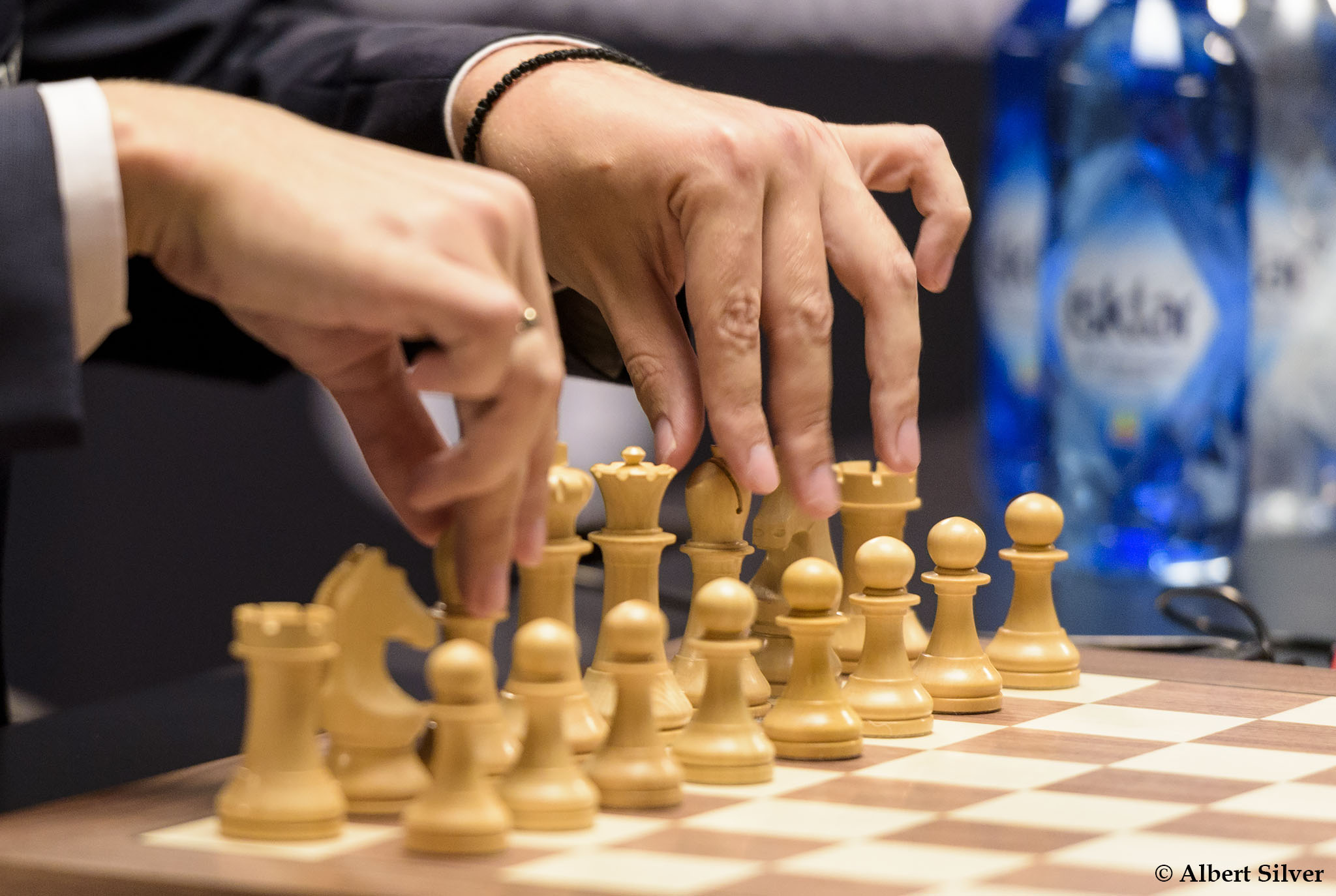
Karjakin adjusts his pieces before the game starts
Play started similarly in spirit to the second game: Sergey Karjakin, playing white, invited a Berlin on the board, while Carlsen showed no fear of the Ruy Lopez with black, an opening that Kasparov had pounded out of Karpov’s repertoire two decades ago. There was a question left hanging though, and that was the World Champion’s refusal to commit himself to …d6, suggesting he planned to play the Marshall Gambit. Whether or not he would actually go through with it if allowed, or would then play the mainline Closed Ruy Lopez is unknown as yet, and Karjakin showed no desire to find out as he opted for an Anti-Marshall system in both game, albeit a different one each time.
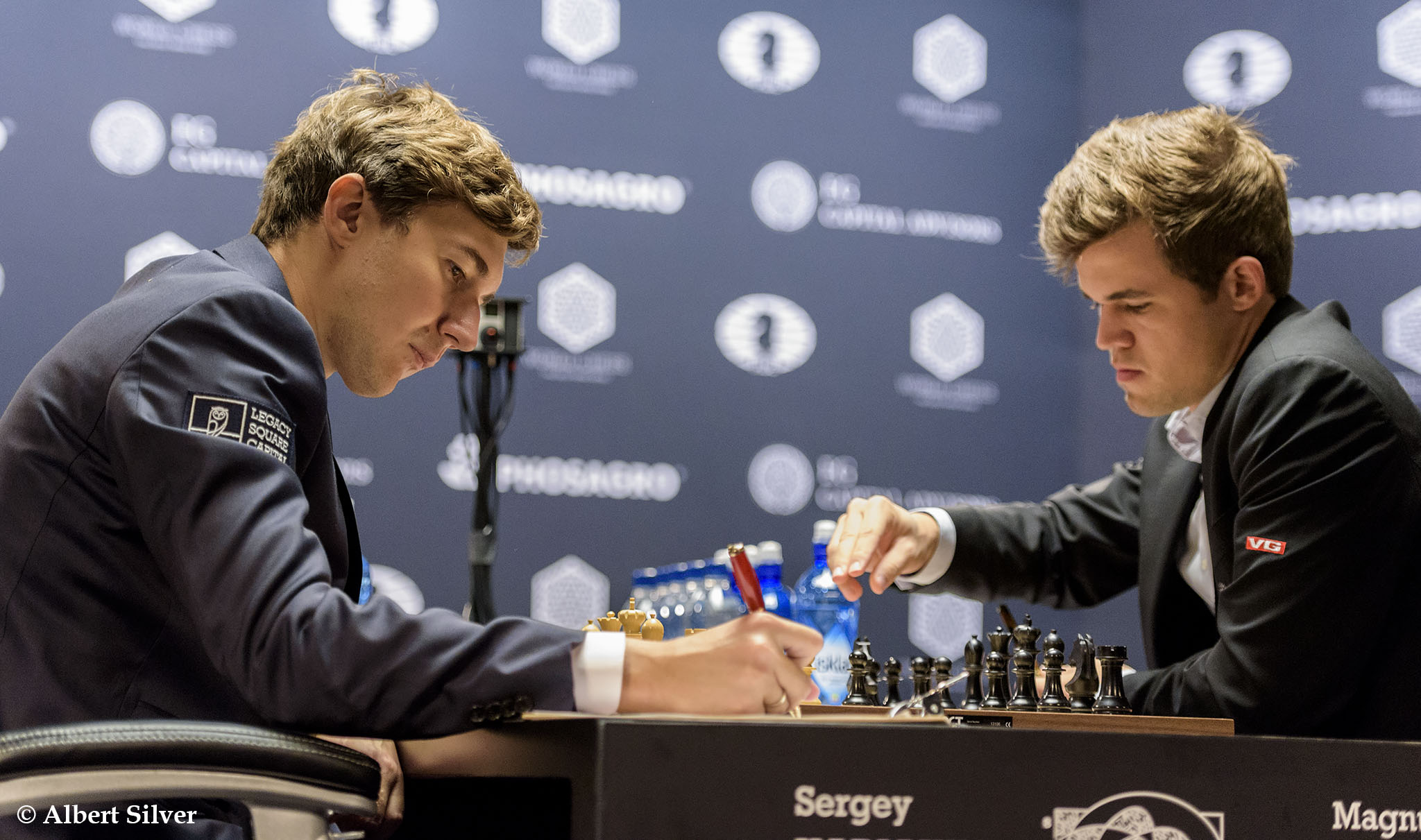
Among the top players, Levon Aronian is without question the foremost practitioner of this line with black, and he has scored a few notable victories, but in spite of it tremendously theoretical background, he has more often used it as a line to secure a draw. Again, whether or not Carlsen has this in mind is as yet unknown. Perhaps as the match unfolds, the mystery will be unveiled.
Karjakin - Calrsen (New York 2016, Game Four)

Position before 18.Bxh6!?
Not deep into the game, Karjakin played the very tempting 18.Bxh6 which led to a significant number of very sharp lines and that he had diligently calculated at the board. In the post-game press conference he said he had at first thought his move was brilliant (with a hint of irony) but soon after regretted his decision as it led to a Pandora’s Box in which he was unsure what he had gotten himself into. The move itself was not wrong, but it also didn’t lead to what he had intended, and he soon panicked and made a genuine mistake right after.
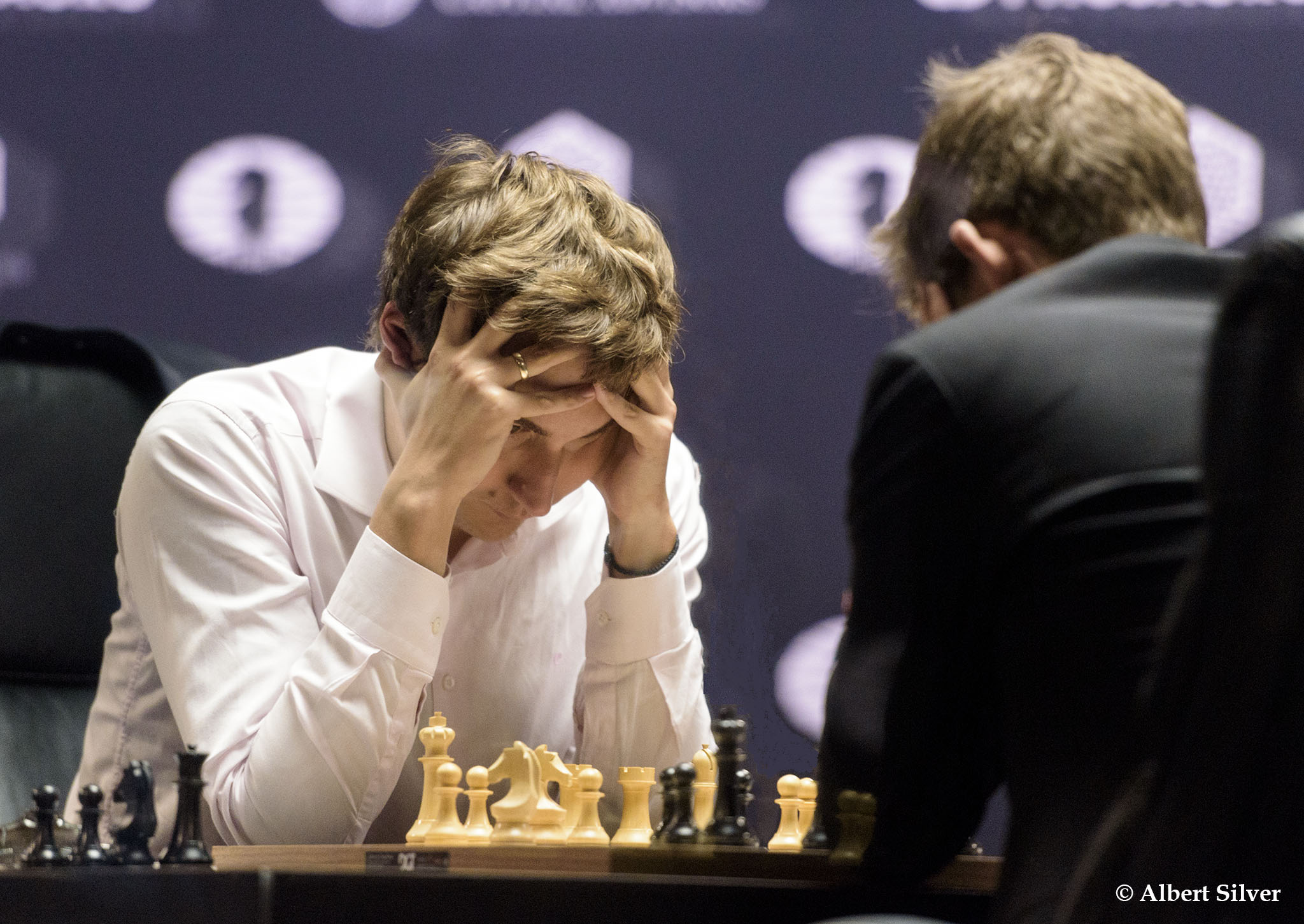
The battle that ensued was nothing short of epic, and while many (this reporter included) thought this was finally going to be the first win by Carlsen, Karjakin once more showed that he had as much resilience as Carlsen had persistence.

Daniel Lucas, the director of publishing of Chess Life magazine, commented that he was staggered at the sheer stamina of both the young players who never wilted even after 6-7 hours of play.
As the game reached its climax and the endgame came, there was no consensus on the result and journalists and fans congregated around the many chess boards in the Café area to analyze the positions at leisure. The engines were no help either as they professed -2 scores in favor of Carlsen, but with no path to improve, rendering their evaluations highly suspect.
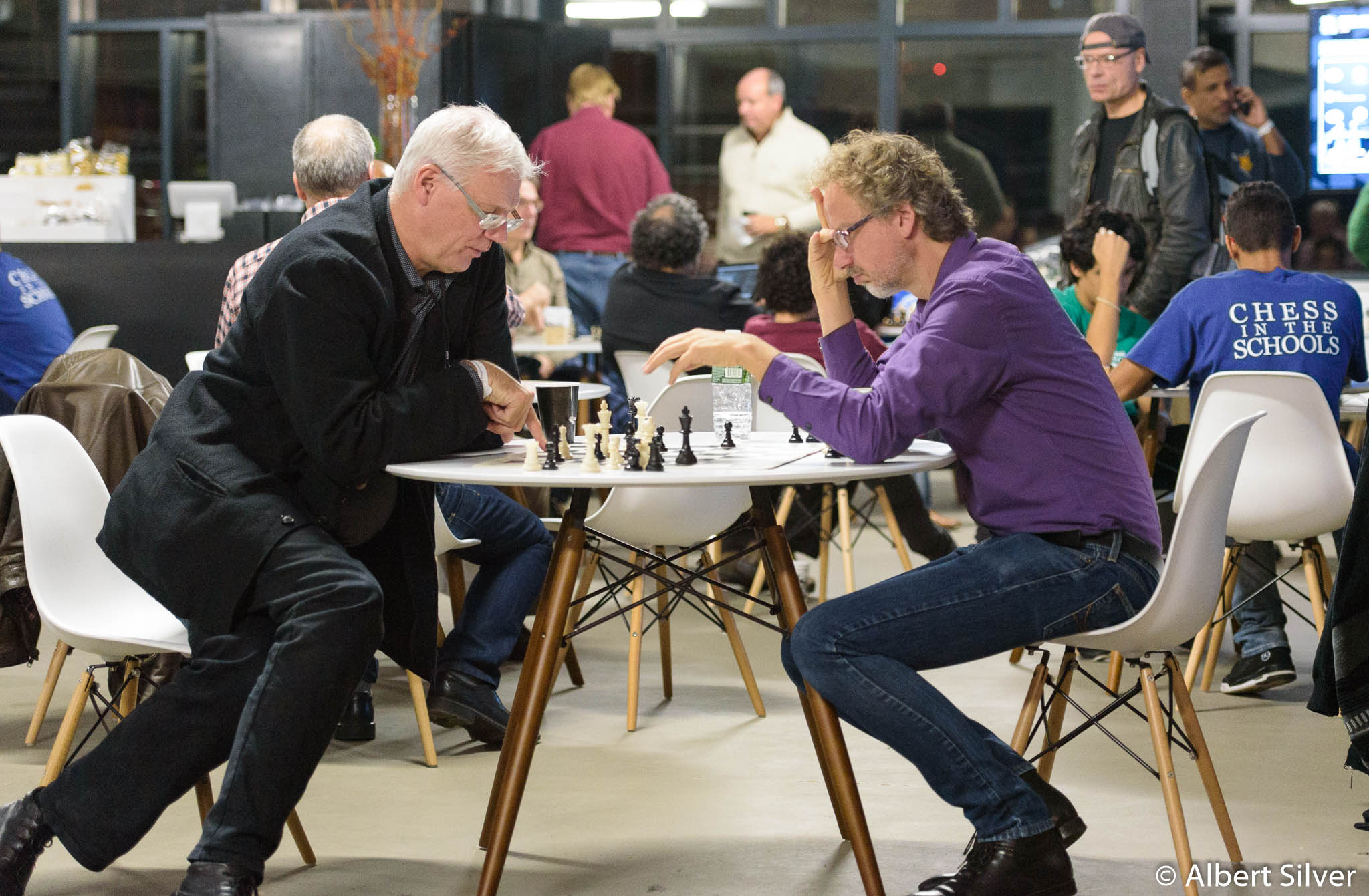
The press spilled out to the Café where there were boards to analyze on
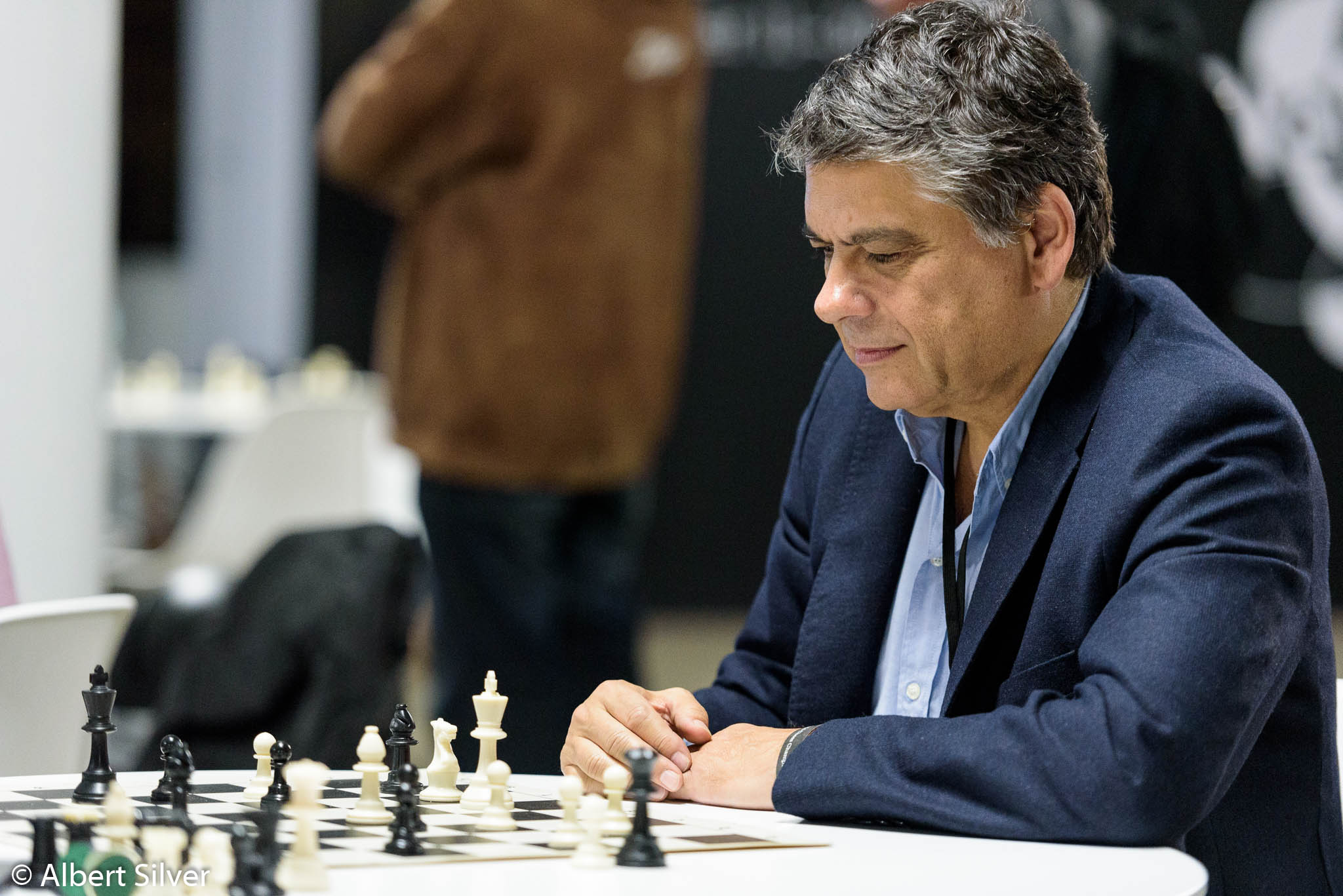
IM Javier Ochoa de Echagüen Estibález, president of the Spanish Chess Federation was also eagerly studying the game with other in the Café
Sergey Karjakin - Magnus Carlsen (annotated by GM Dorian Rogozenco)

[Event "AGON FWCM 2016"] [Site "New York"] [Date "2016.11.15"] [Round "4"] [White "Karjakin, Sergey"] [Black "Carlsen, Magnus"] [Result "1/2-1/2"] [ECO "C88"] [WhiteElo "2769"] [BlackElo "2857"] [Annotator "Dorian Rogozenco"] [PlyCount "187"] [EventDate "2016.??.??"] [EventType "match"] [EventCountry "USA"] [SourceTitle "playchess.com"] [Source "ChessBase"] {Another marathon game in the match, another triumph of defence and another draw... At the beginning of the game four it seemed like Karjakin hadn't quite recovered from the previous tiring encounter, as some of his decisions right after the opening were doubtful.. to say the least. However, in a very critical situation, where most of the specialists predicted a sure win for Carlsen, the Russian Grandmaster again demonstrated his fantastic skills in defending inferior positions and succeeded in achieving the desired draw after almost 7 hours of play.} 1. e4 e5 2. Nf3 Nc6 3. Bb5 a6 4. Ba4 Nf6 5. O-O Be7 { In the second game of the match Karjakin went for 6.d3.} 6. Re1 b5 7. Bb3 O-O 8. h3 {A popular Anti-Marshall system, which tends to lead to a complicated strategical battle, with many theoretical subleties.} Bb7 9. d3 d6 ({Even now Black can play in the Marshall Gambit style with} 9... d5 {but Karjakin has a big experience here, having played it with both colours, so Carlsen decides to go for a positional game instead.} 10. exd5 Nxd5 11. Nxe5 (11. Nbd2 f6 12. a3 Kh8 13. Ba2 Nf4 14. Ne4 Ng6 15. Be3 Nd4 16. Bxd4 exd4 17. h4 f5 18. Neg5 Nxh4 19. Ne6 Nxf3+ 20. gxf3 Qd6 21. Nxf8 Rxf8 22. Kf1 Bg5 23. Re6 Qf4 24. Qe2 Bxf3 25. Qe5 Qh4 26. Qg3 Qh1+ 27. Qg1 Qh5 {0-1 (27) Topalov,V (2752)-Karjakin,S (2779) Astana 2012}) 11... Nd4 12. Bd2 c5 13. Nc3 Nxb3 14. axb3 Nb4 15. Ne4 f5 16. Ng3 Qd5 17. Nf3 Qd7 18. Ne5 Qd5 19. Nf3 Qd7 20. Bxb4 cxb4 21. d4 Rac8 22. Qd3 Bd6 23. Ne5 Qc7 24. Nxf5 Bxe5 25. Rxe5 {and White went on to win in Karjakin,S (2747)-Onischuk,A (2688) Khanty-Mansiysk 2010.}) 10. a3 Qd7 ({Both} 10... Na5 11. Ba2 c5) ({and} 10... Nb8 11. Nbd2 Nbd7 {were played by Carlsen before. However, Karjakin's answer came instantly.}) 11. Nbd2 Rfe8 {[#] Possibly only this move surprised the contender, as he needed 12 minutes to come up with a reply and also spent quite a lot of time afterwards. In his previous games Karjakin faced 11...Rae8 and 11...Nd8.} 12. c3 {So why did it take so long for Karjakin to play this natural move? First of all, despite his huge experience in these type of positions, Karjakin never had this particular one in his practice before. Secondly, the position is quite complicated strategically and it is not easy to figure out whether White needs to play c2-c3 at all. For instance it looks logical to postpone it and start with 12. Nf1. Generally speaking the modern theory considers this type of positions slightly better for White. But again, with a lot of strategical subleties. As the Grandmaster Nigel Short put it: "In such positions, with White I always feel I have no advantage, but with Black that I can't equalize".} Bf8 13. Nf1 h6 14. N3h2 {Preparing the typical active actions on the kingside, which is met by the standard counterplay in the center.} d5 15. Qf3 {White threatens to take on h6 and actually his play is quite easy: Ng3, Ng4 and so on. Black must react very precisely and Carlsen is up to his task.} Na5 16. Ba2 dxe4 {Played after another 10 minutes of thinking.} ({Possibly the World Champion was looking for compensation in variations like} 16... c5 17. Bxh6 c4 18. Rad1 (18. Bg5 {allows} dxe4 19. dxe4 Nxe4 20. Rxe4 f5 {which is very unlear}) 18... dxe4 19. dxe4 Qc6 {but then decided to go for a more solid game continuation.}) 17. dxe4 Nc4 {[#]} 18. Bxh6 {A curious moment here. After a long think Karjakin makes the most principled move, but soon will end up in a very unpleasant position. Taking on h6 is not a mistake yet, but White must have missed something, as his next answer is clearly not a good way to continue.} (18. Ng4 {would have kept the position equal.}) 18... Qc6 $1 {A very precise play by Carlsen. Black had several sharp alternatives instead, but the World Champion rightly rejected them.} (18... Nxb2 19. Bg5 Nh7 20. Bh4 c5 21. Re2 Nc4 22. Bxc4 bxc4 23. Rd2 {and White has an advantage.}) (18... Nxe4 19. Rxe4 Bxe4 ({ loses due to} 19... f5 $2 20. Rxc4 Bxf3 21. Rxc7+) 20. Qxe4 gxh6 21. Ng4 Bg7 22. Nfe3 {with good positional compensation for White.}) 19. Bxc4 $6 {This doubtful move was played after 16 minutes of thinking! Maybe Karjakin already disliked his position so much, that he decided to go for a clearly worse endgame, hoping to hold it. Amazingly, this worked out in the end...} ({ There was still nothing wrong with White's position after} 19. Bc1 {For example:} Nxe4 20. Ne3 Ned6 21. Qxc6 Bxc6 22. Nhg4 {which is about equal.}) 19... bxc4 (19... Qxc4 20. Nd2 $1 {and White keeps his extra pawn}) 20. Be3 Nxe4 21. Ng3 Nd6 ({Both} 21... Nxg3) ({and} 21... Qg6 {were good alternatives as well. In all cases Black has the advantage.}) 22. Rad1 Rab8 23. Bc1 f6 24. Qxc6 Bxc6 25. Ng4 Rb5 26. f3 {[#] Thanks to his bishop's pair and the pressure on b2 Black has a clear advantage. Basically there are two ways to treat the position: to slowplay it with a move like 26...Kf7, improving the pieces step by step, or take immediate actions, what Carlsen did in the game.} f5 {Black uses the fact that the knight cannot go to e3, but perhaps a slow play would have been more unpleasant for Karjaking, who was already feeling some time pressure.} 27. Nf2 (27. Ne3 $2 f4) 27... Be7 ({Perhaps here} 27... Kf7 { was more accurate, as now} 28. f4 {would be a mistake due to} exf4 29. Ne2 Rbe5 ) 28. f4 $1 {As usual, in a difficult situation Karjakin starts to defend extremely well. White needs to simplify the position, as otherwise he will soon run out of air.} Bh4 ({Another attractive option was} 28... exf4 29. Ne2 Ne4 (29... g5 30. Nd4 Rb6 31. Nxc6 Rxc6 32. Rd5 {followed by h4 gives White sufficient counterplay.}) 30. Nxe4 Bxe4 31. Nxf4 Rbb8 {Black is everywhere better and it is not easy to decide which position leaves Black with more winning chances.}) 29. fxe5 Bxg3 (29... Rbxe5 {is not convincing:} 30. Rxe5 Rxe5 31. Bf4 Rb5 32. Rd2 {with very good chances for White to escape.}) 30. exd6 Rxe1+ 31. Rxe1 cxd6 32. Rd1 Kf7 ({After the principled} 32... Re5 33. Nh1 $1 (33. Kf1 Re6 {with ideas like Rg6}) 33... f4 (33... Bh4 {leads nowhere:} 34. Rxd6 Re1+ 35. Kh2) ({but maybe} 33... Ba4 34. Rf1 Bh4 35. Bf4 Rd5 {is the best} ) 34. Nxg3 fxg3 35. Kf1 Be4 {Black has a clear advantage. However, the question remains the same: is it enough for a win?}) 33. Rd4 Re5 34. Kf1 Rd5 35. Rxd5 Bxd5 36. Bg5 Kg6 37. h4 {A very responsable decision in time trouble, as the pawn on h4 will fall soon. In return White gets the possibility to activate the knight via h3.} Kh5 38. Nh3 Bf7 39. Be7 Bxh4 40. Bxd6 Bd8 { [#] The time-trouble is over and we can make some conclusions: White succeeded to avoid the worst and simplified the position. However, even if Black failed to increase his advantage, he still has reasonable winning chances, as the bishop pair together with the chance to create a passed pawn on the kingside are heavy argiments ion Black's favour.} 41. Ke2 g5 42. Nf2 Kg6 43. g4 { Another responsable decision by Karjakin, which again worked out well.} Bb6 44. Be5 a5 45. Nd1 f4 $2 {The decisive mistake, as it limits considerably Black's winning ideas. Carlsen gets a nice passed pawn, but closes the kingside and it will turn out that White can defend successfully his queenside weakness. After 45...Be6 Black must be winning. The World Champion tries hard to win for another 50 moves, but his efforts are in vain and Karjakin achieves again a very important draw.} 46. Bd4 Bc7 47. Nf2 Be6 48. Kf3 Bd5+ 49. Ke2 Bg2 50. Kd2 Kf7 51. Kc2 Bd5 52. Kd2 Bd8 53. Kc2 Ke6 54. Kd2 Kd7 55. Kc2 Kc6 56. Kd2 Kb5 57. Kc1 Ka4 58. Kc2 Bf7 59. Kc1 Bg6 60. Kd2 Kb3 61. Kc1 Bd3 62. Nh3 Ka2 63. Bc5 Be2 64. Nf2 Bf3 65. Kc2 Bc6 66. Bd4 Bd7 67. Bc5 Bc7 68. Bd4 Be6 69. Bc5 f3 70. Be3 Bd7 71. Kc1 $1 ({Although readers will understand that if Carlsen left his g5 pawn hanging, and Karjakin ignored it as if it were a live grenade (very close to the truth), it bears explaining all the same. After} 71. Bxg5 $2 Bb6 72. Bh4 {Black's plan is not to 'recapture' the g-pawn with Bxf2 and Bxg4, which would be a dead draw. His plan is the much nastier} Be3 $1 {threatening Ba4+ (almost mate!) and forcing the win of the b2 pawn and the game.} 73. Kd1 (73. Bg3 Ba4+ 74. b3 Bxb3#) 73... Kxb2 {and White is lost. An ingenious plan showing just how creative Carlsen can be in his efforts to win.}) 71... Bc8 72. Kc2 Bd7 73. Kc1 Bf4 74. Bxf4 gxf4 75. Kc2 Be6 76. Kc1 Bc8 77. Kc2 Be6 78. Kc1 Kb3 79. Kb1 Ka4 80. Kc2 Kb5 81. Kd2 Kc6 82. Ke1 Kd5 83. Kf1 Ke5 84. Kg1 Kf6 85. Ne4+ Kg6 86. Kf2 Bxg4 87. Nd2 Be6 88. Kxf3 Kf5 89. a4 Bd5+ 90. Kf2 Kg4 91. Nf1 Kg5 92. Nd2 Kf5 93. Ke2 Kg4 94. Kf2 1/2-1/2
When they finally shook hands, it was another frowning Carlsen who arrived in the press conference, seemingly unsure what had gone wrong. The analysis was obviously fascinating, but even there emotions were strong.
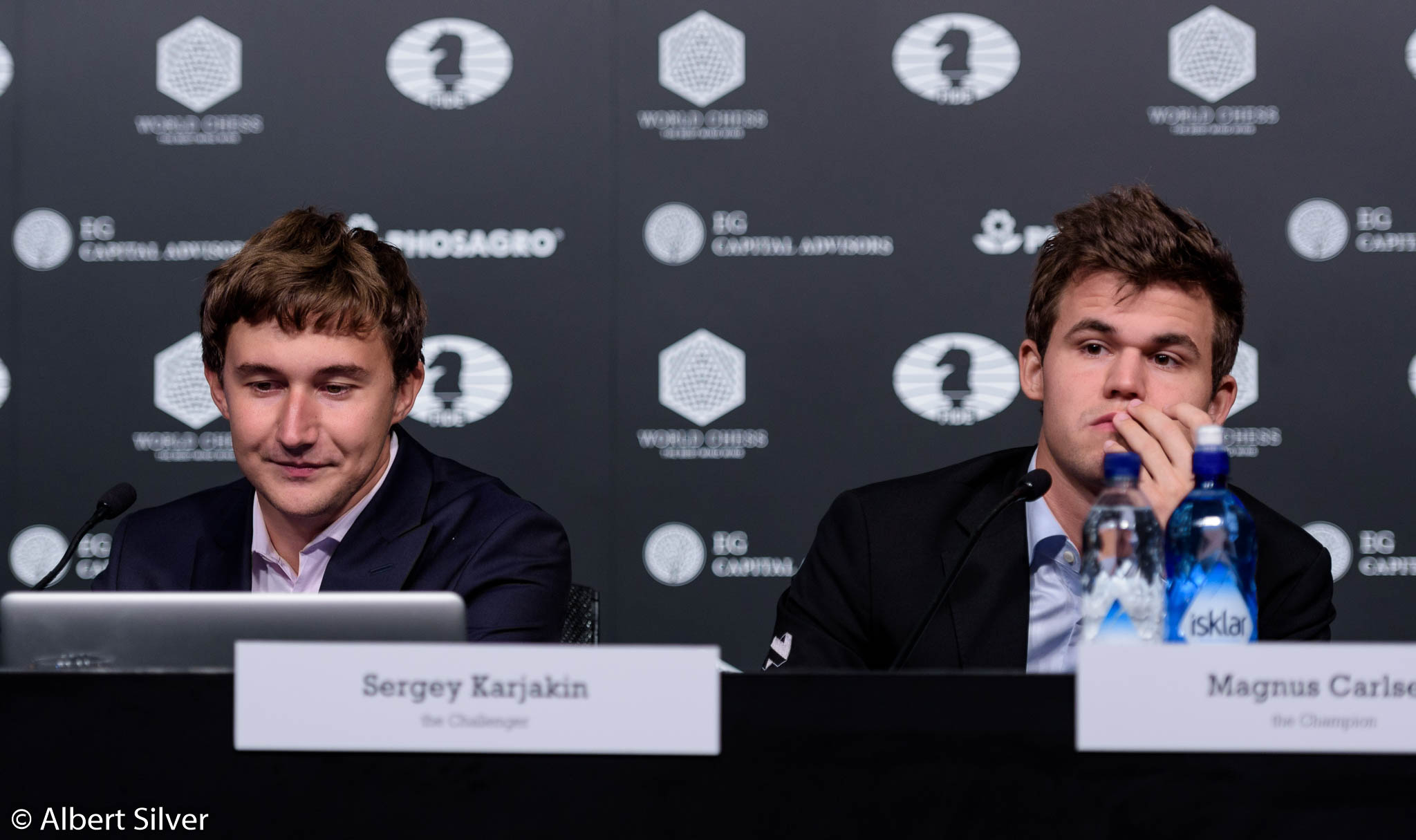
This photo was a mirror image of the scene after game three
With a bit of braggadocio as if to shrug off the taste of failure, Carlsen explained that he did not believe in fortresses and that whenever Anand had been in trouble in their matches he had immediately sought to build one. However he had a talent for breaking them down. Even as he said this, forced to face reality, he acknowledged he had never even considered Karjakin’s plan, and was utterly forthcoming in saying it had never crossed his mind. However, like it or not, he could not question the fortress Karjakin had built and it had proven itself impenetrable.

Carlsen made no excuses and said he simply did not see the fortress idea Karjakin set up
Four games, and four draws. The last two having seemed clearly winning positions for Carlsen. Who gains the most from this? Magnus Carlsen understandably spun it in his favor, stating that it was always better to have been on the attacking side. Nigel Short tweeted agreement with this:

On the other hand, the nearly permanent frown and scowl on Carlsen's face did not look like that of a near-victor, while Sergey Karjakin’s huge smile also told the tale of the day. When asked how it felt to have drawn two nearly lost games, his instant reply with a large grin was, “Fantastic!”

Pro photographers abound at the venue
After the lengthy game and press conference, the few fans left trickled out and the journalists also began planning their dinners. I went out with Pia Petersen and IM Stefan Loeffler for a walk to Chinatown where we hoped to find some inexpensive yet tasty food.
During the previous rest day, I had enjoyed a wonderful afternoon in Chinatown, with pleasant weather and fascinating shops and foods on display all over.
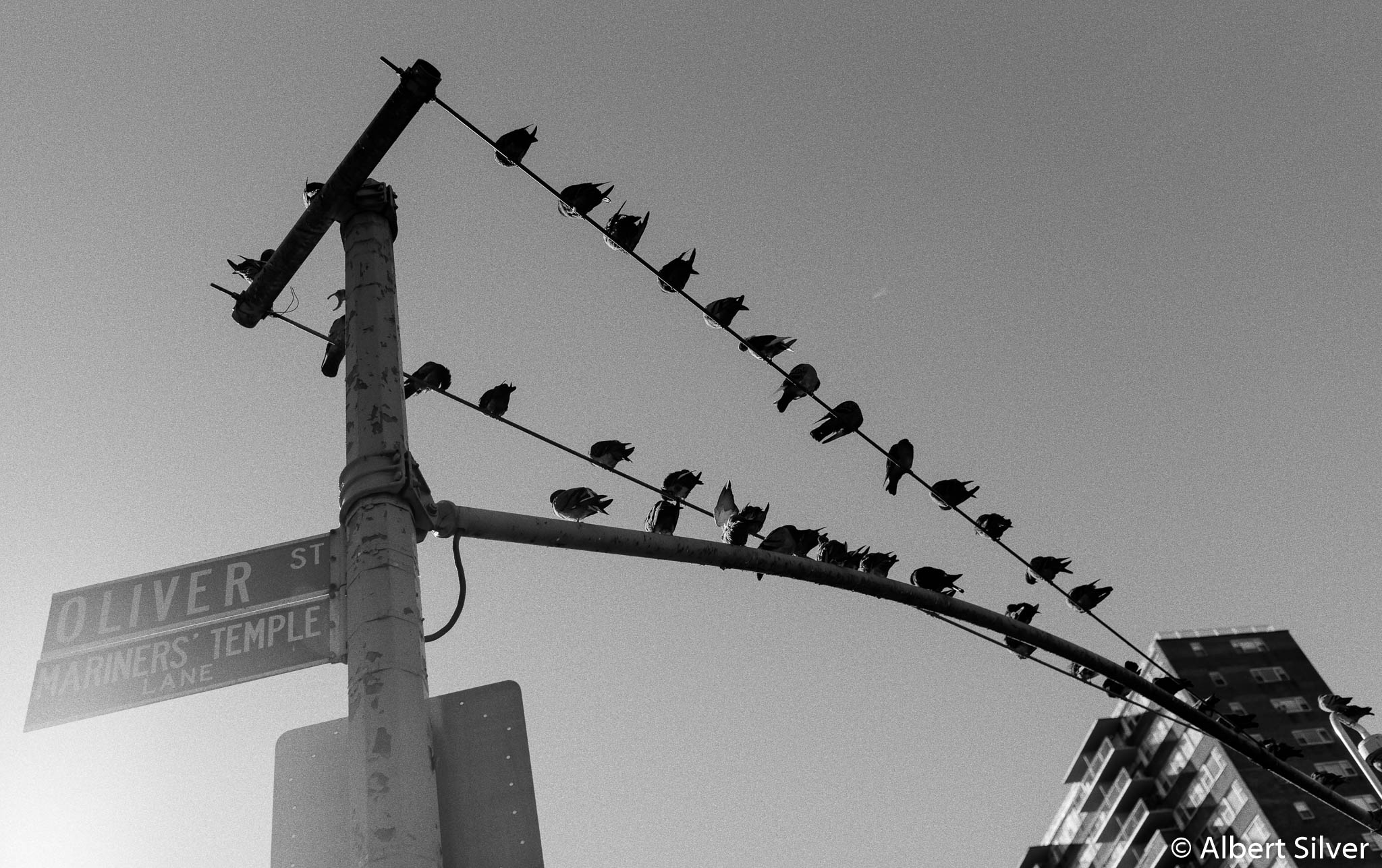
No doubt a normal scene in New York, the geometry and sight of the birds tickeld my sense of aesthetics

One will find these fantastic murals around the city

There are also numerous free publications offered in the streets such as The Village Voice

In the entrance of a narrow alley, one found this makeshift food stall with octopus dumplings
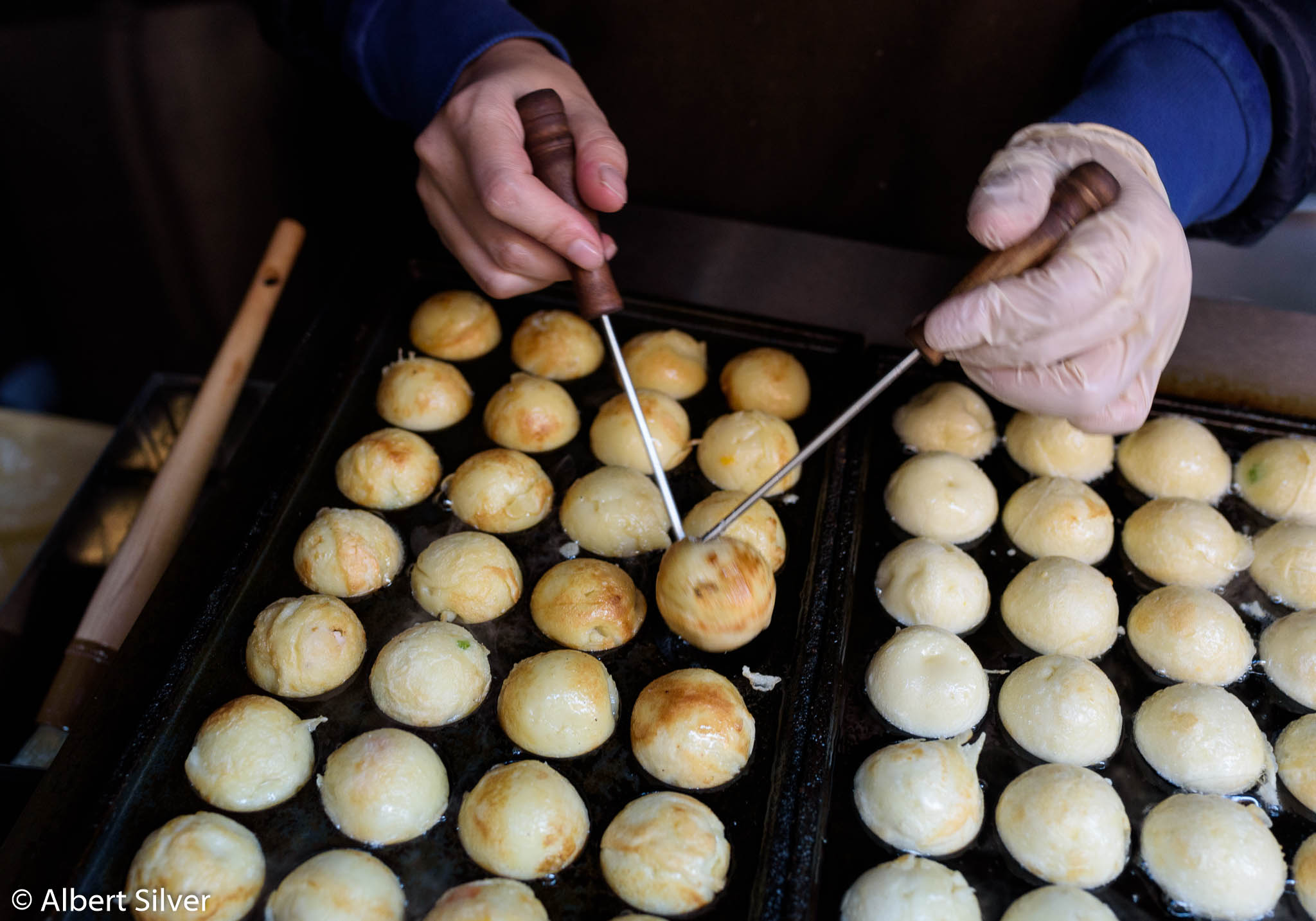
Prepared with expert hands...

... they were served with a sauce and sprinkled with fish scales! Odd-sounding, but delicious.
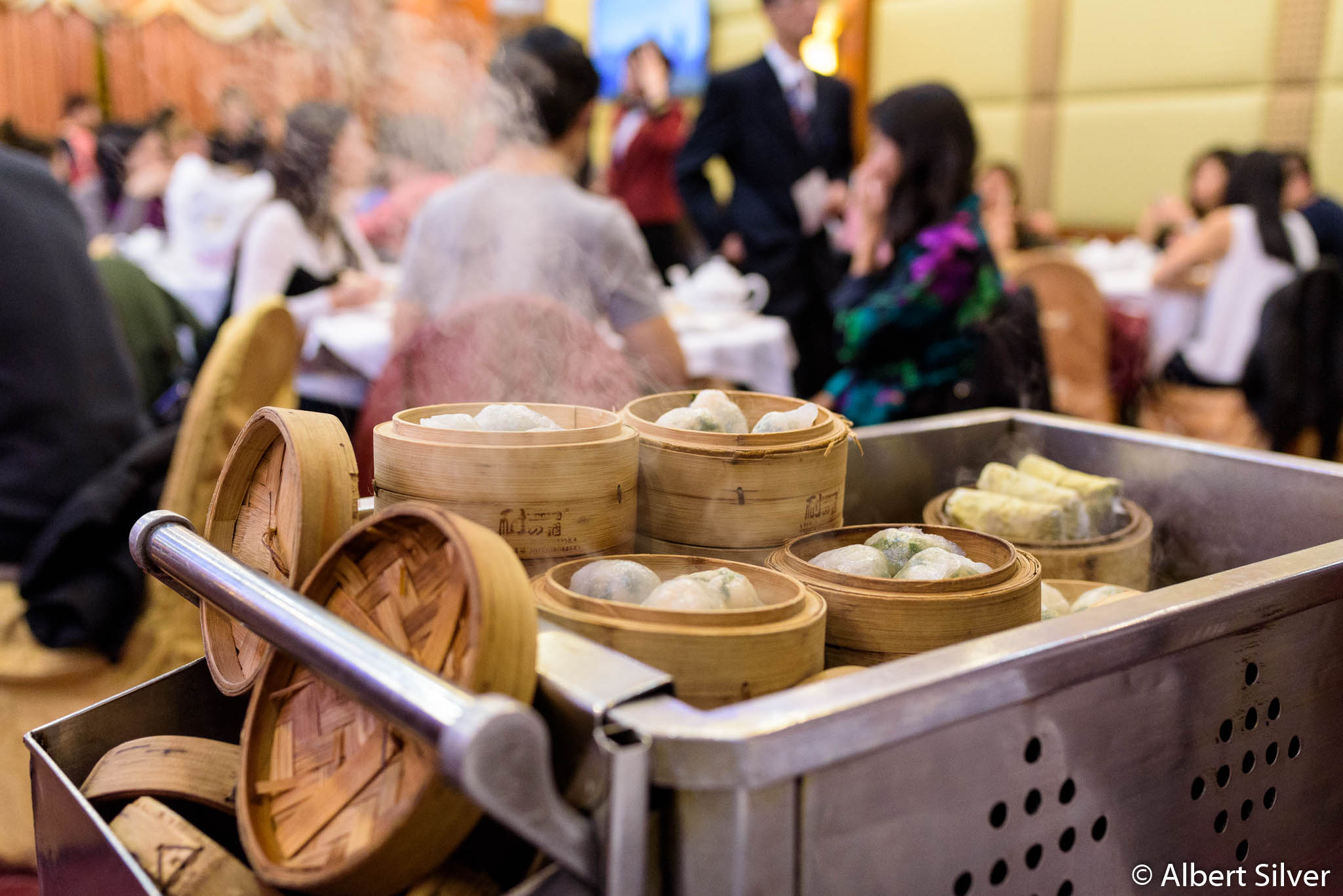
You will also find many restaurants whose fare is so good they bring long lines of Chinese residents

Stores will also offer the oddest items (to non-Chinese a least) such as dried Sea Cucumbers
Now, however, it was quite late, and many restaurants had closed their doors or stopped serving. We walked into a normal (ground floor) restaurant, that immediately said "Sorry, closed! Closed!" My disheartened friends just left and began walking up the street, but I asked the owner for a recommendation. At first he refused, smiling, as if to say "are you kidding me?"
I persisted and said "Look, you're closed, right? So it is not as if you were an option. Plus surely you must eat out yourself sometimes." Along the way in the streets, are a large number of stairways heading into basement areas that are in fact full-fledged business and restaurants. He then pointed to one of those stairways to hell a couple of blocks away and said, "They aren't bad. The fish is ok."
The restaurant was one of the strangest sights you ever saw: Waiters in light blue jackets, handing out bright orange pens, and even selling t-shirts with just the restaurant's name printed on them with their phone in huge letters. It was hard to imagine anyone buying one. The walls were covered in badges, patches, and dollar bills. Truly bizarre, but the recommendation had been a good one as the food was quite good and very cheap.

Enjoying a late Chinese meal with Stefan Loeffler and Pia Petersen




























